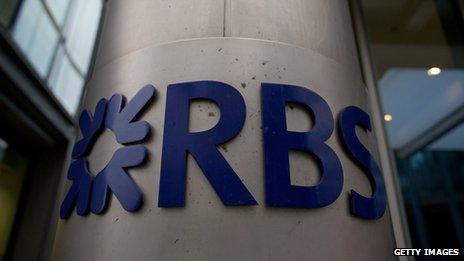Investors want to buy RBS's Williams & Glyn's
- Published
- comments

Royal Bank of Scotland has received an approach from 17 of the biggest investment institutions to buy 315 branches and their associated 2m customers for around £1bn - with a view to creating a serious new player in small-business banking.
I've only been back for four days, and this is the second time I am banging on about Royal Bank of Scotland.
Now I don't know whether that says more about the bruised largely nationalised bank or about me, but either way it may not be healthy.
What has been brought to my attention is an interesting new way to hive off the 315 RBS branches, which the bank was on course to sell to Santander, before the UK arm of that Spanish giant dropped the deal.
RBS is not allowed to keep the branches and their £20bn-odd of deposits and loans - together with 1.7m retail customers and 230,000 small-business clients. The European Commission has ordered the disposal, as a remedy for the state aid received by RBS when British taxpayers bailed it out in 2008.
And here's the thing: the deadline for the sale is November 2013 - though, arguably through no fault of its own, RBS has acknowledged that it is going to miss that deadline.
Or perhaps it might not, if it and the government like the look and smell of a proposal being put to it by 17 very substantial investment institutions, including Schroders, Threadneedle, Foreign & Colonial, Henderson and Invesco Perpetual.
I have learned that together with a sovereign wealth fund, a substantial hedge fund and so-called family money, they've been brought together by Baden Hill and Canaccord to make an offer for the branches.
They've collectively committed £700m, which in a sense was the entry price for getting access to confidential data about the branches, assets and liabilities. And they would expect to eventually make an offer of around £1bn - which is less than Santander had put on the table, but probably more than any other current proposal.
The reason any of this matters is that what is being sold is largely a small-business bank - almost two-thirds of its loans are to businesses, especially smaller ones - and right now one of the alleged great scandals of the British economy is the great shortage of choice for small businesses in the provision of vital finance.
Now you may wonder how on earth these investment funds would propose to run this hived-off bank, which - by the way - would trade under the famous Williams & Glyn's name (many of the branches being sold originally had that moniker).
Well they've recruited the man who set up Tesco's fast-growing bank, Andy Higginson, who was finance director of Tesco for years, as their Williams & Glyn's chairman. As for executives, and risk controls and technology, RBS has already committed to provide all of that.
However, right now Williams & Glyn's is in no fit state to be separated from RBS. And it may take a couple of years for the systems to be in place for it to be detached from the mother ship.
This is how RBS puts it, in its recent results statement:
"RBS is creating a standalone banking entity supported by a bespoke technology solution that would facilitate a trade sale now or at some point in the future, or an IPO (flotation on the stock market)."
It seems to me that the best way of seeing what the investment institutions are proposing is as a short cut to something that's not a million miles from an IPO - since these are exactly the kind of funds that would buy the shares in a stock market flotation.
And the advantage for RBS of their plan is that it can have most of the money almost immediately, rather than having to wait two or three years for the IPO.
The disadvantage of course is that the business could be worth a good deal more, as and when it was floated - and that matters to taxpayers, since we own more than 80% of RBS.
I suspect it may come down to politics, and whether early privatisation of a strategically important part of RBS were to appeal to the chancellor.